Guatemala – Arrival in Central America
(1st June – 3rd July 2016)
were close to crossing the border of the first central American country on our southbound journey without a clue as to what awaited us. At the beginning of our trip we hadn’t even considered spending any time at all in the country. With everything that was reported on the German foreign office website and along with everything else we had heard it sounded almost suicidal. Besides, we hadn’t heard much good about Guatemala to begin with; more horror stories than anything else really. First, we thought of avoiding as much of it as possible by driving through Belize and then making a dash through what remained in a single day. Though as was to be expected our plans and perspectives had changed drastically with our travels and so, with a slightly elevated pulse we drove the last few kilometers towards the border with the plan to cross the entire length of the country.
La Mesilla – Border to Guatemala
This would be our second Latin American border crossing, our Spanish was still at about the same non-existent level and after everything we had read or heard the process for crossing this border would be a dreadfully complex, chaotic, and lengthy process, one which we would have to prepare ourselves for both mentally and emotionally. Our first thought as we approached the border area was “Where is the border to Guatemala?” as there didn’t really seem to be any demarcation zone between the two countries. Somewhere within the chaotic confusion of the border town La Mesilla was the border control building, or more correctly buildings. The town was crammed full of Tiendas, street vendors, food stalls, colorful trucks, Tuc-Tucs, dogs and an immeasurable number of people. Chaos reigned. There was no available parking let alone any signs indicating where to go. The noise level was insane; the shouting of the street vendors mixed discordantly with the barking dogs, engine noises, blaring music, and the honking horns. Somewhat overwhelmed we simply parked the Landy somewhat on the side of the road and headed towards the first official looking building we could find. Actually, it was more a counter than a building, one where you stand outside and talked through a hole in the window. Armed with our trusty dictionary and prepared for several unpleasant hours of frustration we passed our papers through the window happy to still be able to keep an eye out for the Landy. Though, to our utter surprise everything was simple. The officer nodded and smiled friendly, and despite our lousy Spanish the communication was easy. It might look chaotic though it was a simple step by step process that we followed. He pointed us to a copy shop and showed us -using mostly sign language- which papers to copy and how many copies we needed of each -pointing at a paper and then holding up the appropriate number of fingers and then pointing again at the paper. Within a surprisingly short period of time we stood there with our stamped passports and our temporary import permit for the Landy in hand. The only thing we were missing was car insurance. When we asked we were told that we didn’t need any, though we were of a different opinion. Our research stated that car insurance is “technically” required for Guatemala, though finding an agent to purchase said insurance could be difficult – and that was what we had heard from other travelers too. At our border crossing it turned out to be more impossible than difficult. After a short deliberation we decided to forget the insurance and not worry about it – our first lesson in the interpretation of Central American laws, besides what was our alternative? In any event, whatever the horror stories we had heard and read about the border crossing into Guatemala we can’t confirm any of them. After 1 ½ hours we were finished with everything – child’s play even without Spanish skills. Happy that it turned out to be quick and easy we began to take some time to enjoy the spectacle around us. We absorbed the sounds, smells, the riot of colors, the tropical heat, and the whole vibrant life around us. We were in Guatemala! As we slowly drove out of La Mesilla I noticed the license plates of the cars for the first time which had “Centroamerica” printed on the bottom. “Can you believe it!”, I said excitedly to Gary, “We are in Central America! And we drove here!” we looked at each other grinning from ear to ear. Yes, we were actually in Central America. Any remaining feelings of the travel lows of the previous week were gone and excited like little kids we drove our first kilometers on Central American soil.
Huehuetenango
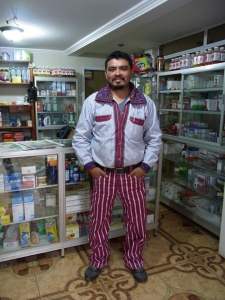 Our first night in Guatemala was spent on the parking lot of the hotel Fuente Real in the nearby town of Huehuetenango (pronounced WayWayteNANgo) which is the capital city of the province with the same name. The hotel had earned a good reputation with Overlanders and not only because of the excellent Italian restaurant onsite. iOverlander had become our primary source of information when searching for places to sleep since “real” campgrounds were becoming rare, and our primary criteria was now security. Things like nice location, quiet, cozy or stylish had to take a back seat – though luckily it turned out not to be too difficult to find a safe camping spot as we soon found out. Certainly, a bright neon parking lot next to a busy highway would never have been our first choice -probably not our third or fourth for that matter, though we were happy to spend our first -not very quiet but worry free- night there. After a day trip to the nearby mountains and town of Todos Santos – famous for its very colorful costumes the men wear- we headed through the highlands towards the fabled Lake Atitlan. Surrounded by volcanoes and a myriad of small villages it has often been described as the most beautiful lake in the world. We wouldn’t go that far, but yes, the Lake is picturesque, the views from above are gigantic, and the drive down to the shore spectacular.
Our first night in Guatemala was spent on the parking lot of the hotel Fuente Real in the nearby town of Huehuetenango (pronounced WayWayteNANgo) which is the capital city of the province with the same name. The hotel had earned a good reputation with Overlanders and not only because of the excellent Italian restaurant onsite. iOverlander had become our primary source of information when searching for places to sleep since “real” campgrounds were becoming rare, and our primary criteria was now security. Things like nice location, quiet, cozy or stylish had to take a back seat – though luckily it turned out not to be too difficult to find a safe camping spot as we soon found out. Certainly, a bright neon parking lot next to a busy highway would never have been our first choice -probably not our third or fourth for that matter, though we were happy to spend our first -not very quiet but worry free- night there. After a day trip to the nearby mountains and town of Todos Santos – famous for its very colorful costumes the men wear- we headed through the highlands towards the fabled Lake Atitlan. Surrounded by volcanoes and a myriad of small villages it has often been described as the most beautiful lake in the world. We wouldn’t go that far, but yes, the Lake is picturesque, the views from above are gigantic, and the drive down to the shore spectacular.
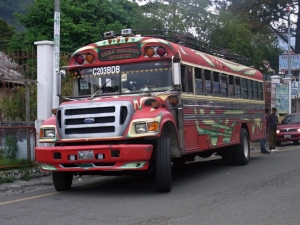 Following the Panamerican highway from Huehuetenango we curved continuously upwards to a pass of almost 3000 meters above sea level where we enjoyed the cool mountain air before heading back down to the tropical lowlands. Driving in Guatemala is dangerous, that was made clear to us within the first few kilometers. After thinking that the driving style in Mexico was aggressive and ruthless we soon realized that it was relaxed in comparison! Jostling and risky overtaking maneuvers are common and a couple of times along our route we passed the demolished remains of busses and cars that went over the steep cliffs. At least on the Pan-American highway there is enough space to swerve out of the way if necessary, unfortunately not so on the smaller secondary roads leading down to the shores of Lake Atitlan. We passed several villages with their packed narrow alleys and the typical colorfully decorated Guatemalan busses before heading down the incredibly steep and twisting mountain road. The busses we had just admired a few minutes before were now careening down the mountain side after us as though the devil himself was chasing them. They overtook anywhere and everywhere including on blind corners as though without a care of what could be around the corner. On the way up the mountain were overloaded pickups, Tuc-Tucs and other busses and we held our breath a few times as we were sure that there was about to be a head-on between two busses but each time the driver was able to swerve out of the way at the last second. Totally stressed we finally reached the bottom and our goal Panajachel, where we finally heaved a sigh of relief. Driving in Guatemala definitely puts a strain the nerves.
Following the Panamerican highway from Huehuetenango we curved continuously upwards to a pass of almost 3000 meters above sea level where we enjoyed the cool mountain air before heading back down to the tropical lowlands. Driving in Guatemala is dangerous, that was made clear to us within the first few kilometers. After thinking that the driving style in Mexico was aggressive and ruthless we soon realized that it was relaxed in comparison! Jostling and risky overtaking maneuvers are common and a couple of times along our route we passed the demolished remains of busses and cars that went over the steep cliffs. At least on the Pan-American highway there is enough space to swerve out of the way if necessary, unfortunately not so on the smaller secondary roads leading down to the shores of Lake Atitlan. We passed several villages with their packed narrow alleys and the typical colorfully decorated Guatemalan busses before heading down the incredibly steep and twisting mountain road. The busses we had just admired a few minutes before were now careening down the mountain side after us as though the devil himself was chasing them. They overtook anywhere and everywhere including on blind corners as though without a care of what could be around the corner. On the way up the mountain were overloaded pickups, Tuc-Tucs and other busses and we held our breath a few times as we were sure that there was about to be a head-on between two busses but each time the driver was able to swerve out of the way at the last second. Totally stressed we finally reached the bottom and our goal Panajachel, where we finally heaved a sigh of relief. Driving in Guatemala definitely puts a strain the nerves.
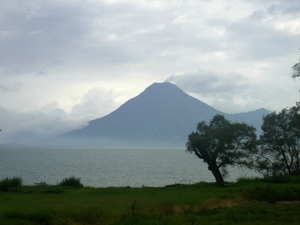 Arrival in Panajachel
Arrival in Panajachel
The village of Panajachel wasn’t only on our list of places to visit because of the beauty of lake Atitlan but for another, more important, reason: We had finally decided to do something about our non-existent Spanish. We may have been able to get by with our pathetic language skills and some sign language, but we will be spending a lot of time in Latin American countries and we want to at least to be able to engage in simple conversations with the locals. Guatemala is relatively well known for its Spanish language schools; at just about every town or village one can learn Spanish – at very inexpensive prices too. Though first we wanted to learn a little bit more about the village and its Guatemalan culture. Panajachel is like most of the towns and villages around Lake Atitlan, very touristy, though thankfully you are neverj far away from the authentic side of life. As soon as you turn off from the “shopping-mile” you land right in the middle of the “real” Guatemala. Colorful houses and huts with corrugated tin roofs line the narrow alleyways where pedestrians, Tuc-Tucs and mopeds (the most common means of transport in Guatemala) vie for space. Most of the population is indigenous and out on the street it’s easy to notice too, not only because of the distinctive facial features but also because of the wonderfully colorful traditional costumes they wear. A lot of both men and women wear traditional clothing sometimes in a riot of colors with intricately woven designs and patterns that differ depending on which village the person comes from. Though don’t wander too long without paying attention! There are no sidewalks in the small alleyways and lanes and they are heavily travelled by Tuc-Tucs who drive just as crazily as the busses, if not more so. For those visiting Guatemala for the first time, like us, you would probably be just as fascinated as we were at how lively it is. Everything is colorful, street vendors clutter the roadsides, and on every corner a Tortilla stand offering fresh hand made corn Tortillas. Pickups pass jammed packed with people every millimeter space used; on the many mopeds woman ride side-saddle behind their men because of their long skirts, often you can see a 4 or 5 headed family on a single moped! On another street we admired the colorfully decorated repurposed school busses – each one a unique artistic expression of the owner. The fragrance of freshly baked bread mingled with that of tropical fruits and grilled meats from the street kitchens; and it all reached a crescendo at the towns market. Similar to the Mexican markets we had visited – though we had the feeling that it was all just a little bit more crowded, and definitely more colorful. From huge stands filled with regional fruits to old grannies sitting on the floor with a collection of freshly harvested herbs and veggies from her own garden arrayed before her on a blanket, you can find practically anything. Again, it is wise to try and avoid the meat section, though generally a visit to the market in Panajachel is always an exciting experience.
Besides the colorful spectacle of the market we also noticed a somewhat more serious detail: The enormous presence of weapons. At almost every public building, especially at financial institutes and supermarkets, stood at least one armed-guard. In almost every delivery truck sat a guard with some kind of weapon mostly a sawed-off shotgun. I was rather shocked at first though and I found it somewhat paradoxical to the colorful life everywhere on one side and the ever present armed guards on the other. It is also very interesting how quickly one grows accustomed to such things, where on the first day the high presence of weaponry gave me a somewhat queasy feeling after less than a week I hardly noticed them anymore, they had simply become a part of the streetscape.
“Jabel Tinamit” – much more than just learning Spanish
After some research the decision for which Spanish school to go to was rather easy: Jabel Tinamit. It is a 100% Mayan owned and operated Spanish school, where, if one so desired could also learn the very interesting Mayan dialect Kakchikel. The owners, Candelaria and Gregorio, have made the school into more of a life’s work in the conservation of local traditions, supporting the needy, building local schools and libraries and connecting international students with locals. The teachers, every single one of them, are simply amazing and the school has a wonderful familial atmosphere. Thanks to the tropical climate the entire school house is more or less open plan and lessons aren’t confined to closed classrooms but rotate throughout various open areas including several garden areas or on one of the many terraces. It is simply wonderful to be taught in such an environment; surrounded by the scent of tropical flowers, the flutter of the many different birds and humming birds that visited the various flowers in the garden. During the pauses the students gather in the veranda for tea, coffee and cookies and relax on one of the several couches. From the veranda roof hang vines with trumpet shaped flowers which spread their sweet scent attracting hummingbirds to flitter around. The whole thing has an almost magical atmosphere – no question we felt right at home and didn’t think too long before signing up for a whole week.
Our Adopted Guatemalan Family
From the very beginning Gary was enthusiastic about staying with a guest family while learning Spanish. I was, however, anything but excited having had several traumatic guest family experiences. At 16 I did an English language course in England and had 3 horrible experiences with guest families one after the other and no desire of risking a repeat experience. I also had one or more not exactly unprejudiced thoughts like “If it went so horribly wrong in England, how much can I expect in a developing country like Guatemala…” Gary had a polar opposite opinion and convinced me that it was time that I worked on my previous traumas. So, I finally agreed at least to give it a go – after all, we are in a completely different situation and could leave at any time if we didn’t like it. “Would you like to meet the guest family first before you decide?” suggested Candelaria with a warm smile – she had clearly anticipated my worries. While arranging a meeting she also gave us an impromptu Spanish lesson before our official start.
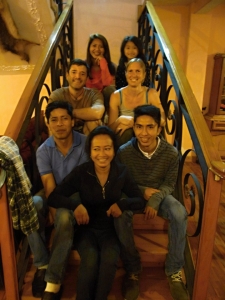 I had pretty much expected anything but was not prepared for Angel, Luki and their exceptional hospitality. We got on immediately with the two of them and their 3 children Ezras, Susan and Alondra, and despite all my previous skepticism the decision to stay with them was very easy. We also were able to park the Landy in the neighbors’ yard and got a nice bedroom with a balcony! Contrary to our expectations and my fears Angel and Lukis house is big, bright and cozy and we were looking forward to a week of family life, of not having to cook or worry about anything really. Despite the still large language barrier we warmed to Luki and Angel quickly. They are used to having people stay with them with little or no Spanish knowledge and are exceptionally patient and interested in their guests.
I had pretty much expected anything but was not prepared for Angel, Luki and their exceptional hospitality. We got on immediately with the two of them and their 3 children Ezras, Susan and Alondra, and despite all my previous skepticism the decision to stay with them was very easy. We also were able to park the Landy in the neighbors’ yard and got a nice bedroom with a balcony! Contrary to our expectations and my fears Angel and Lukis house is big, bright and cozy and we were looking forward to a week of family life, of not having to cook or worry about anything really. Despite the still large language barrier we warmed to Luki and Angel quickly. They are used to having people stay with them with little or no Spanish knowledge and are exceptionally patient and interested in their guests.
The way to “school” led directly through the lively town and over the colorful market, where the offering changes daily. Not really knowing what to expect with such a language course we had signed up for 4 hours per day, one-on-one. As it turned out a rather heavy course load – at least for us – since after four hours Spanish in school we headed directly “home” where we had Spanish for lunch, then Spanish homework and additional extracurricular activities at the school – in Spanish – and then again at supper time and after a lot more Spanish. So-to-say from zero to 100 in a very short time. We made a lot of headway, but our heads started to pound and smoke with the effort. There were one or two people that were doing the same as us but 6 hours per day – for us an inhuman feat –we soon realized that at 4 hours we were at our absolute maximum.
After only two days in our new life it was clear to us that a week was not going to be enough. With one week of intensive Spanish you won’t get very far, though the main reason for wanting to extend our stay wasn’t the Spanish course but more our new family. We didn’t want to leave after only a one week, it was so comfortable with Angel and Luki, such heartwarming people. They enjoy having a lively household and not a single meal went by where we didn’t laugh so hard we had to hold our sides. Angel loves to joke around and even more so when others join it. Quickly we learned the most important phrases that one learns in every language, swear words, jokes and pick-up lines. And as we taught Angel with our newly acquired vocabulary the meaning of “Holz vor der Hüttn” (e.g: “Sie hat viel Holz vor der Hütte” -> “She has a lot of wood in front of her cottage” literally: She has big Boobs) in Spanish he lost it. He was so excited to have a brand-new insider joke that only he would understand. At every possible opportunity we would hear him exclaim “Que Leña” which would mean something like (Look at that pile of wood!) whereby he would dissolve into almost hysterical laughter. So much fun is contagious, and we enjoyed every day of our family life – something that we hadn’t had on our travels. Two new students arrived making the gathering even more enjoyable and lively and without much debate we extended another week, and then another. We had expected a lot but not that we would discover an adoptive family in the middle of Guatemala!
Luki is an excellent cook, our stay became a culinary adventure filled with authentic Guatemalan dishes. From spicy soups for breakfast to a type of sweet porridge to pancakes with Papaya to Plantain bananas in every conceivable variation. Not to forget “Pepian” a classic Guatemalan chicken dish, another that is sort of like a Tamale filled with corn meal and a tasty local herb which we had never heard of before and we also learned how to make “Patches” – a real specialty that is often made in huge batches for gatherings. Similar to Tamales the filling is made with potato or rice and in the middle a piece of meat cooked in a spicy tomato-based sauce wrapped in a huge tropical leaf and then steamed, during which the leaves impart their aroma.
Despite all the interesting and tasty new dishes, the adjustment to the local cuisine was difficult for us. The portions are decidedly smaller than what we were used to, and one filled themselves generally with the ever-present corn tortillas. Made by hand on just about every street corner the tortillas would be bought fresh for every meal and are so cheap that if any happened to be left over they generally were thrown away – the question about rewarming ‘old’ tortillas alone caused Luki to make a questioning face. For a few days everything was fine but after a week we couldn’t see another corn tortilla, tasty as they are. Our digestion rebelled at the over influx of corn and so we informed our hosts that they should no longer buy any tortillas for us, instead we headed off to the market to buy fresh veggies for a bit more fiber in hopes of jumpstarting our digestion again. For them it’s simply inconceivable to have a meal without tortillas, but it wasn’t a problem and they quickly got accustomed to seeing carrot and cucumber sticks as sides on our plates.
Weaving, planting, cooking
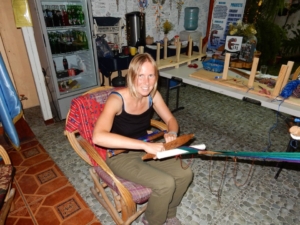 The school offers a lot of extracurricular activities from hiking, day-trips, cooking classes, weaving and philanthropic visits with the locals, however, for the first two weeks we were simply overloaded with our 4 hours per day and homework that we just didn’t have the energy to participate in any of the events. Only after reducing our pensum from four to two hours did we have the energy to do anything else. We started with traditional weaving – something that every woman does and is learned as a child. Guatemala is known for its magnificent handwoven fabrics and we were very impressed with all the assorted designs and such we saw in the markets that we couldn’t pass up the opportunity. For the first time on our trip so far, we went on a souvenir shopping spree. We bought so much that we had to send a package back to Germany. But, you can only find fabrics like that in Guatemala. Try to weave something yourself and you will soon respect how much work goes into the weaving. In the weaving class we found out for ourselves just how extremely time intensive a simple single-color fabric is to weave by hand, a 5cm length took over four hours – in our defense it was also our first time. Never the less our respect for the incredible work rose quite significantly. From a young girl we learned how to make colorful armbands, in the school’s kitchen we learned the secrets of “Mole con Platano” (a super tasty dessert that alone writing about is enough to make me salivate) and I planted an Avocado tree in the garden of a local indigenous family.
The school offers a lot of extracurricular activities from hiking, day-trips, cooking classes, weaving and philanthropic visits with the locals, however, for the first two weeks we were simply overloaded with our 4 hours per day and homework that we just didn’t have the energy to participate in any of the events. Only after reducing our pensum from four to two hours did we have the energy to do anything else. We started with traditional weaving – something that every woman does and is learned as a child. Guatemala is known for its magnificent handwoven fabrics and we were very impressed with all the assorted designs and such we saw in the markets that we couldn’t pass up the opportunity. For the first time on our trip so far, we went on a souvenir shopping spree. We bought so much that we had to send a package back to Germany. But, you can only find fabrics like that in Guatemala. Try to weave something yourself and you will soon respect how much work goes into the weaving. In the weaving class we found out for ourselves just how extremely time intensive a simple single-color fabric is to weave by hand, a 5cm length took over four hours – in our defense it was also our first time. Never the less our respect for the incredible work rose quite significantly. From a young girl we learned how to make colorful armbands, in the school’s kitchen we learned the secrets of “Mole con Platano” (a super tasty dessert that alone writing about is enough to make me salivate) and I planted an Avocado tree in the garden of a local indigenous family.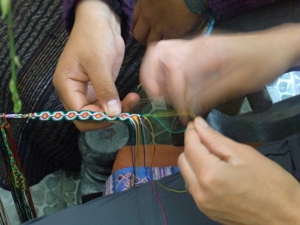 One of the projects of the school is to support the local indigenous rural population and at the same time teach their students a little more about Guatemalan culture. So, on one sunny morning I went with a couple other female students along with Candelaria on an adventurous Pick-up ride into the surrounding mountain-side. Each of us had a young fruit or Avocado tree that we would be donating to a needy family along with a water filter that was donated by other students. The morning would be a very exciting one for all concerned; alone the drive on the open pick-up in the crazy traffic and later along dusty bumpy dirt roads was an adventure. And then we got to peek into the lives of the people living there that we would have otherwise never have had. For the locals the day would be just as exciting since it is very rare to see foreigners in such an out of the way place. Hands were shaken, smiles were wide on both sides, house and garden shown with pride and lots of laughter was had by all. We all admired the incredibly dexterous fingers of the women as they demonstrated their weaving skills. It’s probably not necessary to say that the people here live in some of the poorest of circumstances. The word house, according to “western” standards is quite an exaggeration as most often than not they are simple adobe buildings without windows or doors. Every available accessible area of land is used for planting crops, which in this very mountainous region is no easy task. Sometimes the slopes were so steep that we almost got vertigo when we reached the spot reserved for the new tree. After the plantings we also visited a school and a newly constructed library both of which were either subsidized or sponsored by Jabel Tinamit. It was a very moving and horizon expanding day and we certainly learned respect for the people who eke out their existence in such conditions.
One of the projects of the school is to support the local indigenous rural population and at the same time teach their students a little more about Guatemalan culture. So, on one sunny morning I went with a couple other female students along with Candelaria on an adventurous Pick-up ride into the surrounding mountain-side. Each of us had a young fruit or Avocado tree that we would be donating to a needy family along with a water filter that was donated by other students. The morning would be a very exciting one for all concerned; alone the drive on the open pick-up in the crazy traffic and later along dusty bumpy dirt roads was an adventure. And then we got to peek into the lives of the people living there that we would have otherwise never have had. For the locals the day would be just as exciting since it is very rare to see foreigners in such an out of the way place. Hands were shaken, smiles were wide on both sides, house and garden shown with pride and lots of laughter was had by all. We all admired the incredibly dexterous fingers of the women as they demonstrated their weaving skills. It’s probably not necessary to say that the people here live in some of the poorest of circumstances. The word house, according to “western” standards is quite an exaggeration as most often than not they are simple adobe buildings without windows or doors. Every available accessible area of land is used for planting crops, which in this very mountainous region is no easy task. Sometimes the slopes were so steep that we almost got vertigo when we reached the spot reserved for the new tree. After the plantings we also visited a school and a newly constructed library both of which were either subsidized or sponsored by Jabel Tinamit. It was a very moving and horizon expanding day and we certainly learned respect for the people who eke out their existence in such conditions.
The days and weeks flew by, our Spanish improved daily and we enjoyed the ever-expanding conversation with our guest family though we turned a little melancholy at the thought that our time was limited and we would soon need to move on. Then something happened that once again threw all planning out the window and which would drastically change our stay quite unexpectedly and unwillingly. Gary found an oil leak that most probably came from the Crank-shaft oil seal behind the timing belt. We exchanged anxious looks and it was clear that we would need spare parts – sent to Guatemala. That means we were stuck – for an indefinite period of time.

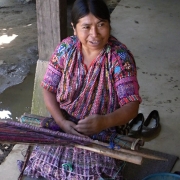
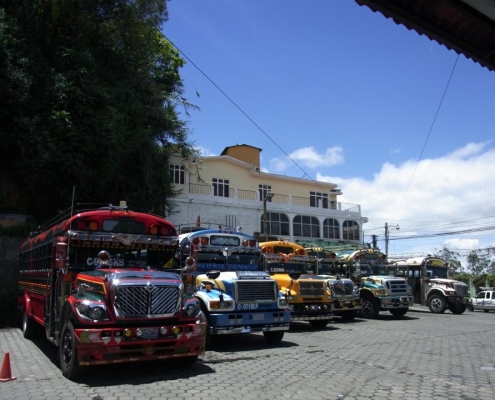
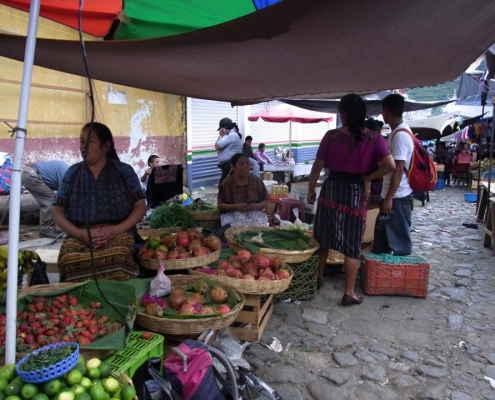
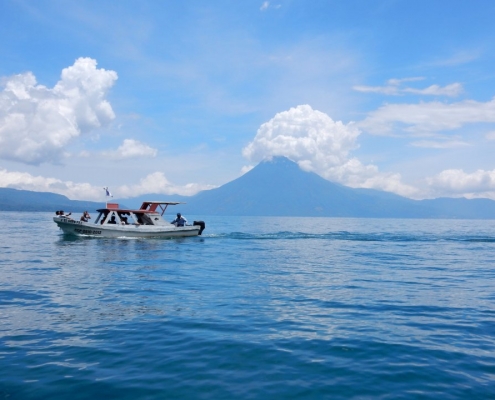
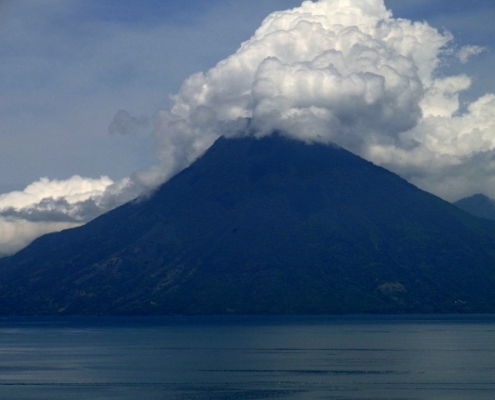
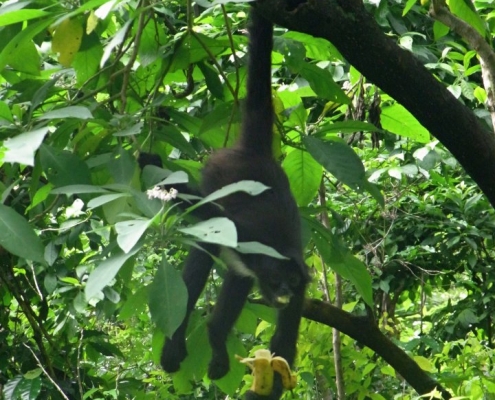
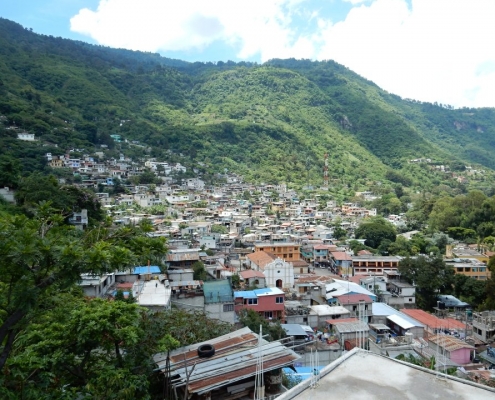
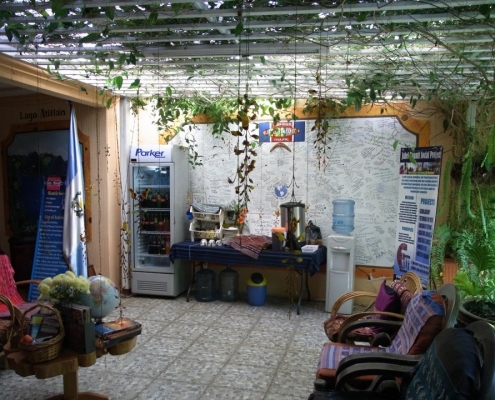
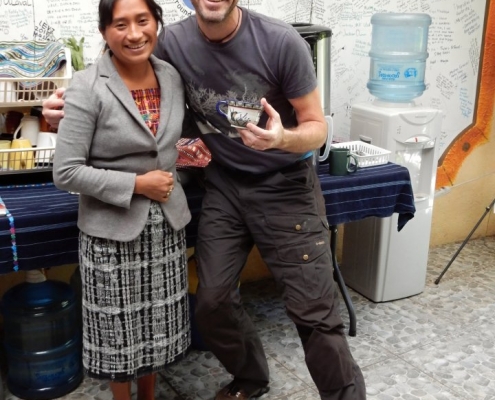

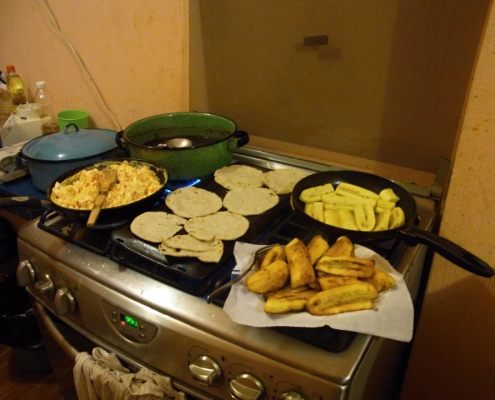
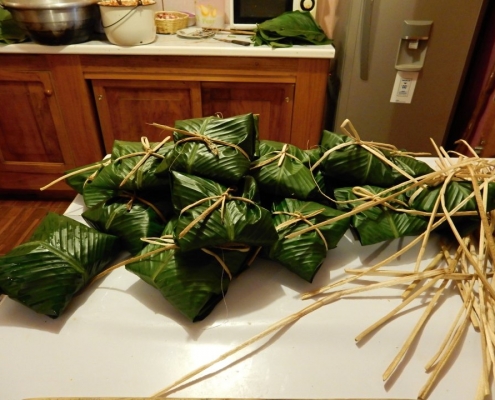
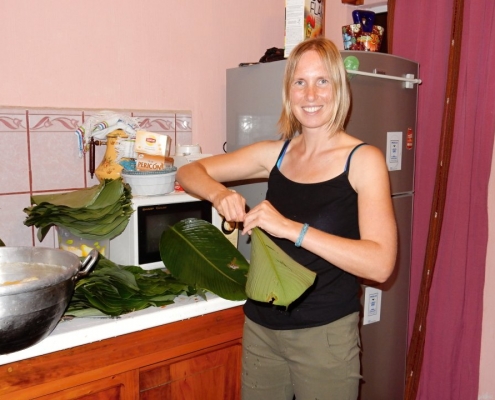
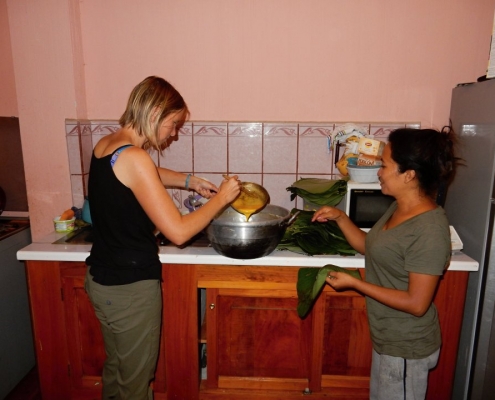
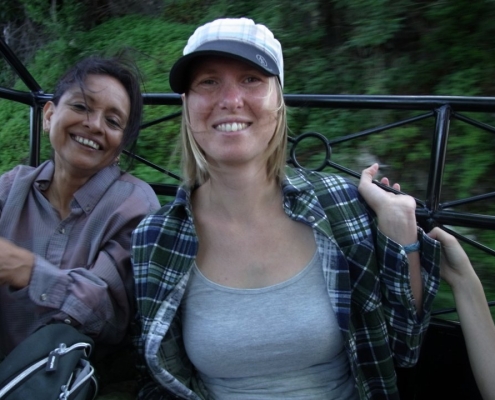
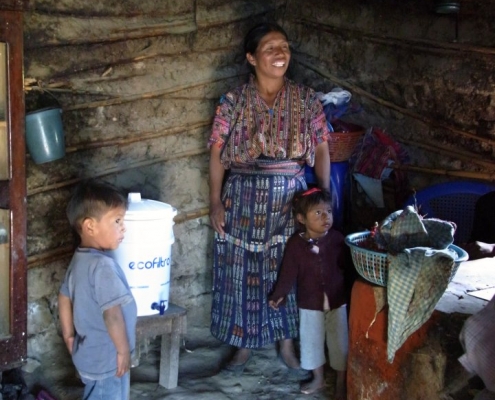
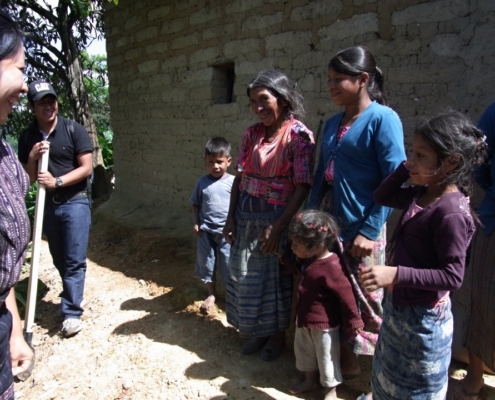
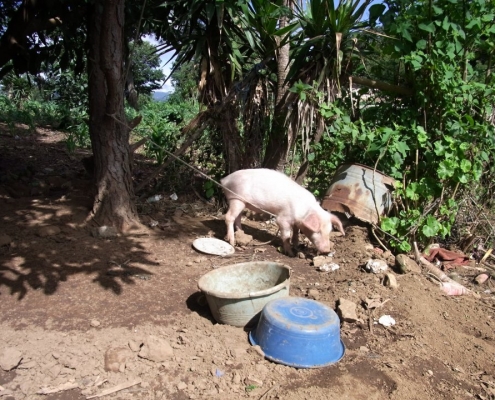
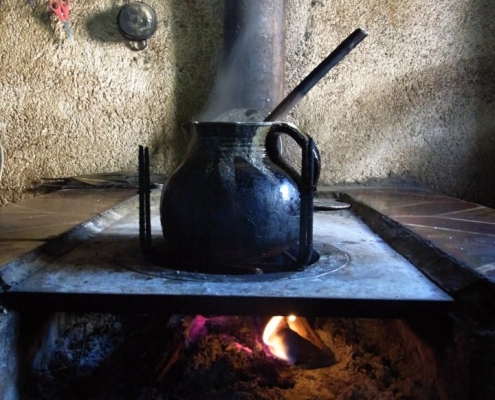
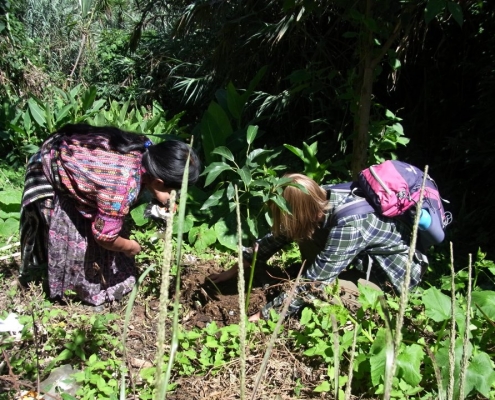

I finally finished reading, wow! How was your Spanish after three weeks? I looked up the website of the school you attended I thought I would choose 2 hour regimen, as you are saying one gets a lot of practice outside as well. So, maybe two or three weeks for me (I have some bare basics). 4 hours a day would definitely be too much for me.
Also, why did you pic one-on-one – wouldn’t two of you at the same lesson make it easier to pick up stuff, you could share ideas/impressions – one would think there would be some additional synergy?
And again, thank you for sharing, don’t wait too long before the next installment! :)
Great, you’re considering Jabel Tinamit. If you go, give them a big hug from us! In our opinion with 2 hours a day for two to three weeks you’ll get definitely further – especially if you do some other activities as well and think of living with a guest family. You can also hang out in the school and use their library the whole day if you feel the need to do more. We chose one on one because everybody learns differently, and it’s much more intense if you’re the only student and have to concentrate the whole time. We would do it exactly the same way again, but as said with only two hours a day 😊
Guys, thank you for keeping at it, I am looking forward to seeing your report about the trip to Antarctica :)
One observation|friendly note: it would be much easier to read if the text was split into smaller paragraphs and the paragraphs were separated by an empty space.
Hi Vadim,
Thanks for the feedback, appreciate it!